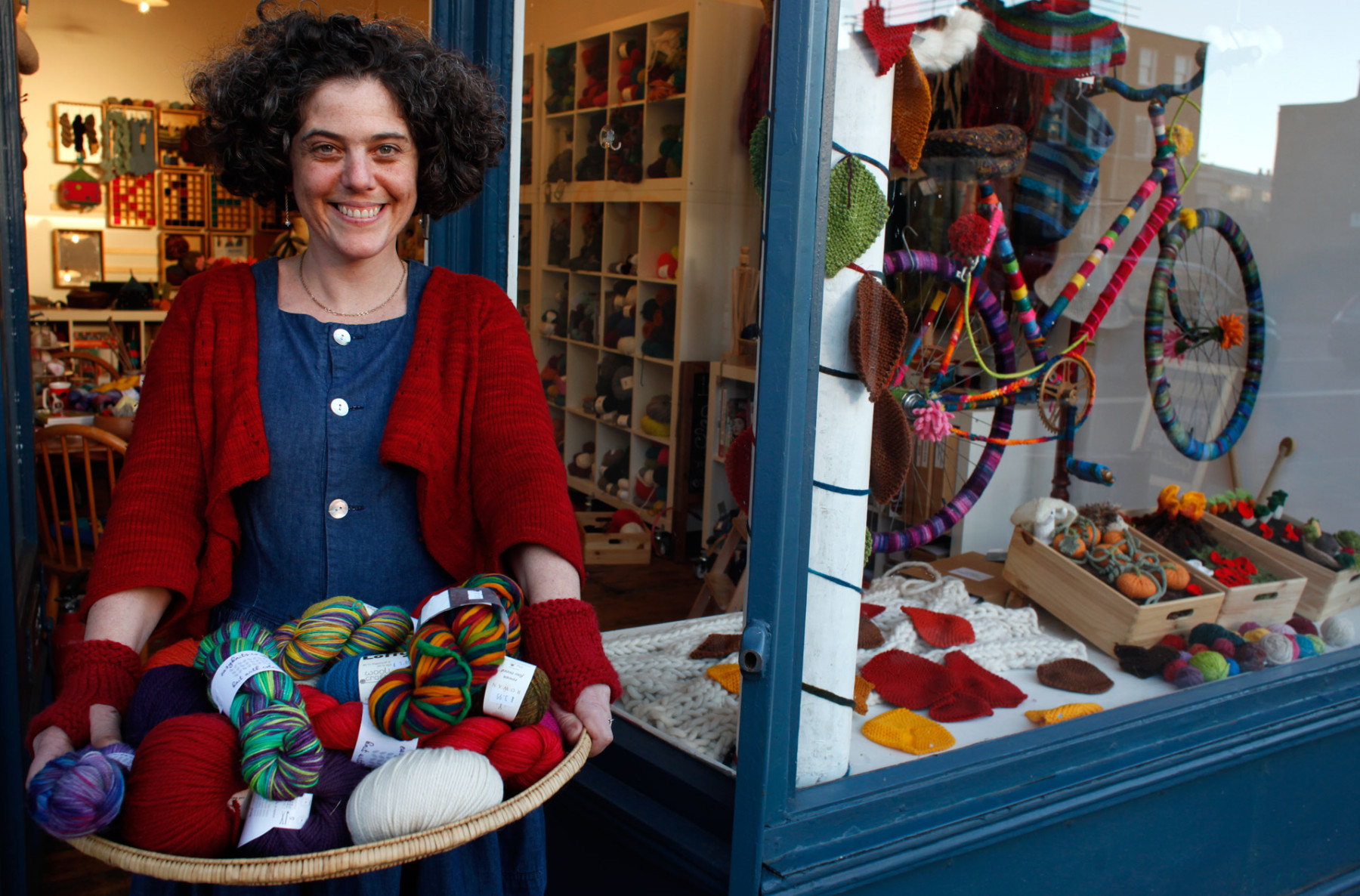Is there really a Madonna of the Yarn Winder?
Well there’s a painting with that name by Leonardo Da Vinci that shows the Madonna, her naked child and something that looks like a niddy noddy meets drop spindle contraption. It’s had a bit of an adventurous time lately – stolen by robbers disguised as policemen and eventually returned to the Scottish Laird that owns it, by means of similar subterfuge.

But why are we talking about it now?
Only because the heist story put me in mind of the whole ball versus skein thing – The yarn winding condundrum – why we buy some yarn wound already, and other yarns unwound.
OK, let’s start with the skein then. How does that work?
You untwist the skein into a big loop, place the loop around a person’s outstretched arms or the back of a chair or your knees, cut each of the ties that are holding it in place, locate the end of the yarn and begin winding it around your fingers, giving your ball a half turn every so often so that it can form a nice spherical shape.
Can’t I just knit with it straight from the skein? Does it matter if I don’t bother winding it?
It matters. Things don’t end well if you knit directly from the un-balled skein.
So why don’t the people who make yarn, make it into a ball before they sell it on? Why does your shop have some yarn in balls and some in skeins?
It’s an obvious question to ask, but surprisingly difficult to find a straight answer to.
Except if you’re talking to a hand dyer…
The process of cooking the yarn up in a pot containing soluble dye, needs the yarn to float freely in the liquid, to take on colour all the way through. Long haired knitters will relate here – you know how your hair doesn’t get wet through in the shower when it’s tied up? Similarly the outside of a ball will obstruct the inside from soaking up the dye.
Ok, so they need the yarn to be in a loose loop skein to dye it, but why can’t they wind it into a ball afterwards for the knitter who’s going to work with it?
Mostly because ball winding machinery is big and expensive, and hand dyers tend to be very small scale producers who are not working with that kind of equipment. It makes sense in terms of production costs and pricing for the dyer to leave that task to the knitter.
Mostly?
Well the other thing about hand dyed yarn is that it looks so very beautiful when its twisted into a skein. It stands apart from industrially dyed balls and says at a glance, ‘this is special and one of a kind.’
Ok, I get it, but it’s not just hand dyed yarn that comes in un-balled skeins. Sometimes it’s like that even when it comes from a big industrial mill.
My pet theory is that the hand dyers have had some unintended influence here. Now that their special slow-cooked, small production colourways always appear in skeins, they have helped knitters to make an association between twisted skeins and hand-crafted production – so that big mills which have ample ball winding capacity, choose to leave the yarn un-balled in skeins so they can market it as more of an artisinal product, knowing it will hang in skeins like the hand dyed yarn does.
Isn’t that a bit cynical?
Well perhaps a more generous way to put it, is that the industrial producers have seen how nice yarn can look when it is displayed in a skein. And practically speaking, skeins are more suited to the peg-board shop fittings that yarn stores use for displaying skeins. Plus weight for weight, it tends to take up less space when it’s all packed up for shipping. So it has a practical advantage too.
So that’s all there is to it? No niche ultra-knitter insider intel on the superiority of storing yarn in un-balled hanks rather than winding them into balls?
I get it – you want the geeky angle, and not my boring shop-fittings, box-packing, marketing blah blah. So there is a school of thought which holds that yarn which is stored in a loosely twisted skein will be better preserved than one which has been wound into balls.
Ha hah! I knew it!. Does this mean I get to join Team Skein, and be a bit smug about not winding my yarn until I’m about to knit with it?
Honestly? I’ve never been able to tell the difference between yarn that was stored in a skein or a ball. So I’ve consulted Wild and Woolly’s most revered yarn geek, Wendy Peterson (creator of Yarnsub.com and the Yarn Geeks Newsletter). She explains that the affect on a given yarn of winding it into a ball “..will depend on fibre content and probably yarn weight.” But she adds that “yarn manufacturers know this and take it into account with their ball winding equipment, which is why we don’t sell rock solid balls of wool! And even our home yarn winding equipment can mitigate here. Ball winders tend to have that large core to wind round, so even if the yarn is pretty taut as it comes off the winder, that central hole gives it space to expand into and the pressure is released off the wool, as soon as the yarn comes off the ball winder.”
Yarn thickness and tightness of spin is also relevant here. Wendy explains it like this.. “You could store a tightly twisted sock yarn in a ‘too tight’ ball and it’s not going to make much difference when you unearth it from your stash five years later. But if you store a sproingy aran weight wool in rock solid form, then my guess is that you won’t get reliable results when you’re knitting. All that pressure will get ‘stuck’ in the yarn and won’t be released as you knit it.
But there’s an important caveat here – as she adds that the yarn will.. “‘unstick‘ and the fibers will go back to their ‘native‘ structure when you block.” In this sense, blocking’s restorative powers trump over-eager ball winding.
Wendy’s conclusion is that “The moral of the story is: treat your yarn nice and always swatch and block!”
And so whole balls versus skeins thing? I think it’s probably not really a thing afterall. But if your thing is yarn in balls, and the skeins wind you up (geddit?), don’t forget we’ve got lovely swifts and ball winders for you in the shop.

